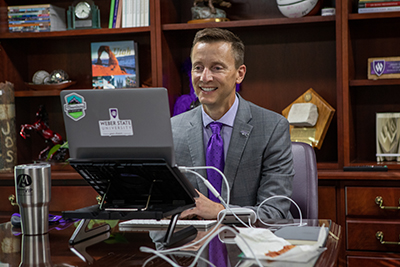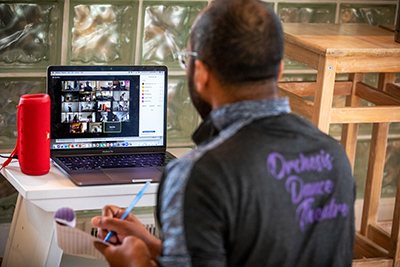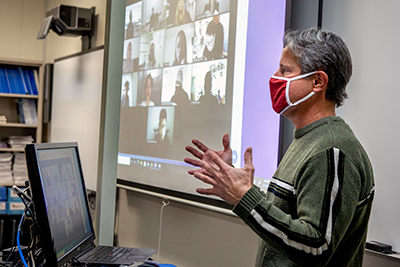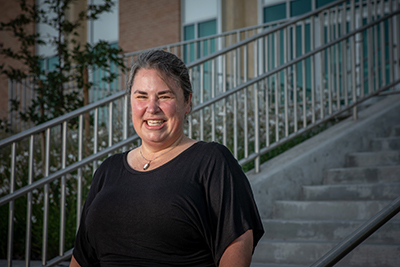Weber State Reflects on Year of Pandemic, Looks Forward to Future
OGDEN, Utah – After meeting and overcoming the challenges of a pandemic, Weber State University is gearing up for a fall semester that offers more opportunities, more connections and more flexibility than ever before.
.jpg) On June 14, the university relaxed its COVID-19 guidelines, paving the way for campus to return to pre-pandemic activities. Traditional fall events such as Experience Weber (Aug. 26-27), Wildcat Block Party (Sept. 3) and Homecoming (Oct. 8-16) are scheduled to happen in person this year. Fall sports are expected to have a regular schedule, with Wildcat football kicking off Sept. 2 against the University of Utah. And most importantly — many of WSU’s fall courses will once again be taught face-to-face.
On June 14, the university relaxed its COVID-19 guidelines, paving the way for campus to return to pre-pandemic activities. Traditional fall events such as Experience Weber (Aug. 26-27), Wildcat Block Party (Sept. 3) and Homecoming (Oct. 8-16) are scheduled to happen in person this year. Fall sports are expected to have a regular schedule, with Wildcat football kicking off Sept. 2 against the University of Utah. And most importantly — many of WSU’s fall courses will once again be taught face-to-face.
That “vibrant, in-person fall semester” relies on students, faculty and staff being vaccinated against COVID-19 and continuing to follow safety measures from state and local health departments and the CDC, said WSU President Brad Mortensen.
“People have really stepped up and done a great job over the last year,” he said. “Now, we’re taking what we’ve learned and are ready to be back in person.”
Administrators reflect on 2020-21
Students, faculty and staff faced a number of challenges over the last year, beginning when WSU made the switch to online learning in March 2020 as COVID-19 spread throughout the country. Not knowing how long the pandemic would last or how changing protocols would affect university operations were two of the most difficult aspects of the last year, Mortensen reflected.
“I think the uncertainty has been the most challenging part for everybody — administration, faculty, staff and students. We didn’t know for sure how things were going to progress throughout the year, especially the fall 2020 semester,” Mortensen said.
Mortensen and other university administrators tried to alleviate some of that uncertainty by keeping in touch with WSU community members through 22 virtual town halls, held every few weeks during the first few months of the pandemic and then monthly as the 2020-21 school year began. At its peak, between 500-600 people attended the town hall conversations.
 “We never imagined we’d do that many town halls,” said Steven Richardson, director of strategic initiatives. “I think there was an appreciation and a sense of looking forward to the president giving updates and being available for feedback.”
“We never imagined we’d do that many town halls,” said Steven Richardson, director of strategic initiatives. “I think there was an appreciation and a sense of looking forward to the president giving updates and being available for feedback.”
WSU’s COVID-19 task force was continually at work in the background, meeting often to discuss new developments and recommendations from health departments; adjusting campus policies and timelines; organizing massive COVID-19 rapid testing opportunities for students, faculty and staff; and working with the Weber-Morgan Health Department to open a community vaccination site at the Dee Events Center in January.
“There’s nowhere in the world I’d rather have been than Weber State to go through what we did last year, and that’s because of the people,” Mortensen said. “So many people stepped up and made things happen, both at an institutional level and on a personal level for students.”
Like many other institutions, Weber State also grappled with the legacy of racial injustice in America, rising political tensions, and other social and economic issues rising from the pandemic that shaped 2020.
“All three of those contributed to this understanding that, as a university, we need to be a place where difficult conversations can happen and not everybody is going to agree on some of these major issues,” Mortensen said.
The university held several town halls for students and staff to discuss their concerns about racial issues on campus, and hosted noted antiracist scholar Dr. Ibram X. Kendi, civil rights activist Ruby Bridges and Asian American activist Helen Zia during the spring semester as part of a continued effort to promote a more diverse and inclusive campus environment.
These conversations and events were also important in shaping the goals of Weber State’s five-year strategic plan, especially those focused on equity, diversity and inclusion, Mortensen said. Equity is the “foundational principle” for fulfilling WSU’s mission as an open enrollment institution, the plan reads, and is integrated into all parts and outcomes of the plan.
“The pandemic heightened the awareness of the need to sharpen our focus for the future,” Mortensen said. “The world is changing around us and if we don't take the opportunity to plan our future, somebody else will do it for us and we won't be in a strong position to serve our students and our community going forward.”
Learning and teaching in a pandemic
WSU held minimal face-to-face classes on campus in fall, but offered more in-person and hybrid options in the spring as vaccinations became more available.
By the end of fall 2020 semester, more than 400 faculty members had taken advantage of faculty development opportunities designed to hone online and virtual teaching methods, said Brenda Marsteller Kowalewski, associate provost of high impact educational experience and faculty excellence.
 “Teaching during a global pandemic has taught us a great deal about effective methods of teaching and learning for all students,” Kowalewski said. “As we move forward into a new normal during fall 2021, our faculty will continue some of their more effective virtual practices regardless of course delivery mode.”
“Teaching during a global pandemic has taught us a great deal about effective methods of teaching and learning for all students,” Kowalewski said. “As we move forward into a new normal during fall 2021, our faculty will continue some of their more effective virtual practices regardless of course delivery mode.”
Adjustments faculty made included holding virtual office hours, being more flexible with courses and keeping students engaged in a digital environment. For the Jerry & Vickie Moyes College of Education Assistant Professor of Teacher Education Stephanie Speicher, that meant creating a compassionate late policy for assignments and revising her syllabus to be more effective.
“Teaching over this past year is what I needed to shift my paradigm,” she said. “On a professional level, I found myself in the throes of having no choice but to learn new skills and techniques to connect with my students and help students connect with each other and the content. I felt like a first-year teacher all over again.”
Speicher said she appreciated the array of tools available to help heighten her digital classroom experience.
“From the Google Suite to Padlet to Flipgrid, I really fell in love with all these tools,” she said. Padlet is a real-time collaborative web platform and Flipgrid is an educational discussion tool. “It really changed my teaching routine and for that, I’m forever grateful.”
Political science and philosophy professor Leah Murray said the disruption of the pandemic gave her an opportunity to take courses on how to better her teaching methods and use digital tools to enhance her in-person classes, something she will continue to do..
WSUSA president Ben Ferney said teachers were supportive and proactive with the switch to virtual learning during the fall.
“I know that students went through so many things. Some of them lost family members, had COVID themselves, or they had all kinds of different troubles throughout this year,” he said. “I hope that we can give ourselves grace and be kind to ourselves if we're not doing what we hoped we would do or doing things differently than normal.”
Many students struggled with their classes while balancing a social life and staying safe, Ferney said. He and other students often experienced “digital fatigue” from the number of classes or meetings conducted online.
 “You could spend your whole day without leaving your room,” Ferney said. “It’s a different level of performing you have to do when you’re virtual. It doesn’t fulfill you as much as when you’re in a classroom.”
“You could spend your whole day without leaving your room,” Ferney said. “It’s a different level of performing you have to do when you’re virtual. It doesn’t fulfill you as much as when you’re in a classroom.”
With the numerous social and political issues that popped up in 2020, Murray said the digital environment made it difficult to know if students were getting what they needed out of her political science classroom discussions. In one class alone, she taught 104 students via Zoom.
“Education is conversation. In a Zoom environment, students can just turn their video off. Whereas in a classroom environment, you can see how they’re interacting and feeling,” Murray said. “With the year we had, it was very contained inside Zoom. Students reaching out like they would in the classroom dynamic wasn’t happening as much.”
To engage with students, Ferney hosted “Bagel on Ben” events throughout fall and spring semester where students received a coupon to Einstein’s Bagels in the Shepherd Union Building and could chat with him while they waited for their bagel to arrive. WSUSA also held a number of virtual giveaways and events, like a paint night, to keep students connected to campus and each other.
“Moving online forced us to reevaluate the way we do things, the way we connect with students,” Ferney said.
Murray, who is also the academic director of the Olene S. Walker Institute of Politics & Public Service, said going digital helped voter registration efforts on campus in the fall. Weber State registered more voters than “ever before” in part because they were able to reach students they otherwise wouldn’t have by using digital tools, she said.
Speicher said she found being transparent, honest and vulnerable with her students during this time was beneficial.
 “The students appreciated all of the deliberate activities and experiences to bring them together and provide a space to just talk,” she said. “In every class, I incorporated opportunities for us to check in with each other, such as wellness checks.”
“The students appreciated all of the deliberate activities and experiences to bring them together and provide a space to just talk,” she said. “In every class, I incorporated opportunities for us to check in with each other, such as wellness checks.”
Despite the challenges, Weber State graduated a record number of students in spring 2021, 6,497 – an indication that students were getting the support they needed from faculty and staff, Mortensen said. Weber State was able to hold in-person commencement ceremonies at Stewart Stadium this spring largely because of all the hard work, sacrifice and willingness from the campus community.
“In those few days, I sensed a lot of healing and pride for people in their accomplishments,” Mortensen said. “Being able to celebrate that together showed Weber State’s commitment to our students and graduates.”
Moving forward
As Weber State emerges from the COVID-19 pandemic, many of the lessons and technology adaptations used in the 2020-21 school year are here to stay.
“Weber State faculty won't be ‘going back’ this fall to teaching as it always has been,” Kowalewski said. “Rather, faculty are ‘going forward’ with teaching innovations learned over the last year that will continue to be refined to provide the best learning outcomes for our students.”
This spring, WSU’s Digital District opened in Lampros Hall, which allows the university to support even more faculty with their teaching needs regardless of whether they teach in person or online. The university is likely just beginning to see the impact of the technology adaptations made in the last 14 months, Mortensen said.
Faculty are ready and excited to see students in a more traditional semester setting this fall, Speicher said.
.jpg) “Know that we are fully aware of the lasting impacts and consequences — positive and negative — that we all experienced during this historic time,” she said. “Those experiences will shape and impact how we move forward, to make us stronger, more compassionate, and ultimately prepared to help students achieve their goals and dreams.”
“Know that we are fully aware of the lasting impacts and consequences — positive and negative — that we all experienced during this historic time,” she said. “Those experiences will shape and impact how we move forward, to make us stronger, more compassionate, and ultimately prepared to help students achieve their goals and dreams.”
Murray said she got vaccinated against COVID-19 as soon as possible so she could get back to in-person teaching with her students.
“I’m very much looking forward to that energy of being in a classroom,” she said. “We as faculty had to change on a dime and I think for the most part, we rose to the challenge. We can do hard things.”
Ferney, who graduated with his bachelor’s in spring and is returning this fall to complete his Master’s of Professional Communication, said he’s looking forward to another year as student body president on campus.
“For a year, we’ve hung out on Zoom. We’ve been on our phones, we've social distanced, we've had all of those things,” he said. “And while we might still do some of those things, fall semester is going to be an opportunity for us to really jump back into life, reconnect and wake back up from the chaos of the year.”
Visit weber.edu/wsutoday for more news about Weber State University.
Jessica Kokesh, social media editor
801-626-7316 • jessicakokesh@weber.edu- Contact:
Allison Barlow Hess, Public Relations director
801-626-7948 • ahess@weber.edu